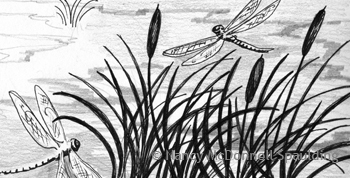RAINSHADOW WORLD - A Naturalist's Year in the San Juan Islands
PREFACE
On a warm day in May not long ago, I took a walk along an upland trail at the University of Washington Friday Harbor Marine Laboratories. I was eager to see what wildflowers were blooming on a rocky knoll overlooking the harbor, and delighted to find camas still in flower; shiny western buttercups gleaming in the grass; blue-eyed Mary nestled in crevices alongside stonecrop; pink clusters of sea blush clinging to the bluff; and the pods of white fawn lilies that reminded me that a full year would pass before I gazed again upon their soft petals.
I stopped to look at a broad-leaved starflower that cast a tiny shadow under a towering fir, then watched a spring azure flutter by and land in the camas, promptly folding its wings and disappearing into the rich hues of the plant’s blue flowers. A bald eagle made slow measured turns high above madrones, western red cedars, and Douglas firs anchored in the bedrock; chestnut-backed chickadees and dark-eyed juncos foraged in the early creamy inflorescence of ocean spray; and, at Beaverton Cove, a sleek river otter came ashore and lumbered off through the understory of salal, western sword fern, and Oregon grape.
On a grassy bald, I found a little plant I did not know. It was reminiscent of candyflower, its succulent stems with delicate white flowers veined in pink trailing inconspicuously along the lichen-encrusted rocks. I sketched the tiny wildflower and made notes of the landscape. Later, consulting a botanical guide, I identified the plant as moisture-loving montia, Montia parvifolia, named for the eighteenth century Italian botanist Giuseppe Monti.
It was the type of walk I liked the best: investigating unfamiliar niches along a trail; finding new plants to identify; and pondering birds, butterflies, and other wildlings. And, thanks to an islanders’ community that still values wild places, there is plenty of room to roam. The San Juan Archipelago embraces hundreds of rocky resting places scattered from the mainland of northwest Washington to the Strait of Juan de Fuca. There are 375 miles of shoreline on more than 400 islands, rocks, and reefs visible at high time. The San Juan group is generally regarded as including Cypress, Guemes, Sinclair, and Lummi Islands to the east although those islands are not part of San Juan County.
For years, I  have conducted surveys, kept journals, compiled checklists, taken classes, and joined colleagues and friends in the field delighting in the process of discovery. As a resident of San Juan Island, I have primarily observed the prairies, forests, wetlands, and rocky shorelines I call home, but my visits to Shaw, Orcas, Lopez and the outer islands of Cypress, Stuart, Waldron, and Yellow have produced engaging encounters, too.
have conducted surveys, kept journals, compiled checklists, taken classes, and joined colleagues and friends in the field delighting in the process of discovery. As a resident of San Juan Island, I have primarily observed the prairies, forests, wetlands, and rocky shorelines I call home, but my visits to Shaw, Orcas, Lopez and the outer islands of Cypress, Stuart, Waldron, and Yellow have produced engaging encounters, too.
The mild climate allows me to explore the archipelago virtually every day of the year. This realm lies beneath the rainshadow of the Olympic Mountains. The passage to the outer coast—the Strait of Juan de Fuca—splits a mountain range between Vancouver Island and the Olympic Peninsula. Rain clouds surging in from the Pacific Ocean surrender moisture to the western slopes of the nearly 7,000–foot peaks, leaving the San Juans, to the north, with less than thirty inches of precipitation each year. The summers are temperate and the winters, while wet and wind-blown, seem moderated by my curiosity.
The islands have stirred to life my senses of wonder and of joy. Years of wandering, watching, and listening have been my way of keeping in touch with this rainshadow world—and with myself. The island year depicted actually spans a decade of experiences and investigations from the late 1990s through 2009. Changes in the landscape and wildlife communities, both subtle and stark, have occurred during this period illuminating the inevitable adaptations of a natural world increasingly impacted by human development. The book is a snapshot in time and, I hope, an accessible reference point for understanding what has come before and what may lie ahead for this extraordinary place. I have asked more questions than I have answered, and the journey has just begun.
Susan Vernon
Friday Harbor, Washington
Website copyright by Susan Vernon 2023 All rights reserved.
No portion of this website may be reproduced in any form without the expressed written permission of Susan Vernon /Archipelago Press.
Illustrations on this website copyright 2021 by Nancy McDonnell Spaulding.